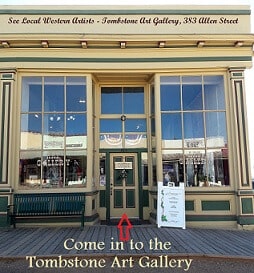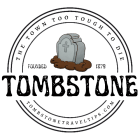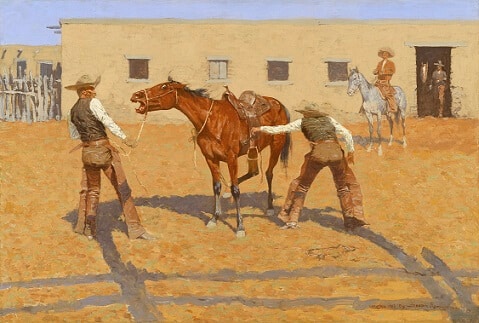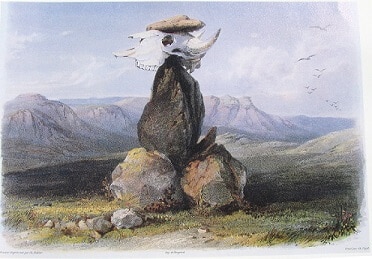Western Art was a creative American form starting in the 1880s. It followed the course of Western expansion promoted by the U.S. government.
People in the Eastern states were excited by happenings in this new territory. They read news stories and serial novels in their newspapers. They purchased Dime Novels. These described exploits of daring cowboys, traders and explorers in the Wild West! They attended some traveling Wild West Shows, like the production of the famed Buffalo Bill Cody. What more could add to their vicarious experiences? Western Art!
Western art provided superior visualization of these unique landscapes. People got a good look at the vistas, the people and the activities of these distant adventures.
Even today, many people in the U.S. – even worldwide – love and collect Western art. In our family home, we have some Western themed artwork on our walls. Our family members also love this style of art. Especially those who live out West.

Tombstone’s Western Art
Tombstone Arizona supports its own style of Western Artwork. On Allen Street, near the corner of 4th Street is the Tombstone Art Gallery. It features artists and crafts persons from the local area.
During the holiday season the Tombstone Art Gallery has many wonderful and unique items that can be used for gift-giving. Even year-round you’ll find many stand-out items you’d love for your home.

Every February the Tombstone Art Gallery sponsors a month long event. Get all the details on our Tombstone Event Page>
We update the details for their Tombstone Quilt Show when it is near.
Famous Western Artists
Many artists have painted, drew, and sculpted works reflecting Western culture. Two old west artists were the most prolific, probably the most talented and the most famous. They were Frederic Remington and Charles M. Russell.
Frederic Remington
Born in 1861 in Canton N.Y., he was an only child. His father was in the Civil War, rising to a Colonel’s rank.2 He hoped Frederic would attend West Point. But all during his youth, Frederic wasn’t a good student. Instead he showed early artistic talent. His top subjects were cowboys, horses and soldiers. He was athletic, though: involved in swimming, horse-back riding, hunting, camping.3
He thought he’d be a journalist and involve some art work. He attended Yale art school,2 but wasn’t serious. He was distracted by their sporting programs. He continued drawing on his own time – his own subjects, which differed from his classroom’s expectations.3
Frederic left school when his father contracted tuberculosis. After his father died, he worked miscellaneous odd jobs. In 1881 he took a trip to Montana to see what he could do. Maybe working in mining or with cattle. He went on some real Western style adventures. He was enthralled actually seeing things he’d heard about all his life.4 From that trip’s experiences, he published his first drawing in Harper’s Weekly.3
He then tried ranching in Kansas. It didn’t suit him. Frederic became involved in an unsuccessful business venture in Kansas City. Then he became half-owner of a saloon in town. A year later he traveled home, back East, where he married his first sweetheart, Eva Caten. Then together they went West to Kansas City, and settled down.3
All the while he was sketching the Western life surrounding him. Cowboys, horses, saloon patrons, etc. But his wife was unhappy with this life. She left, returning to her home in the East.
The saloon wasn’t bringing in much income. So Frederic began painting more seriously now. His paintings started to sell in his area of Kansas.
Then he decided to return to his hometown. Frederic and his wife reconciled.3 He signed up for courses at The Art Student’s League in New York.2 That was much more to his style, I think, from reading of his life. They aren’t as strictly structured in their required coursework. I know a bit about the school, since as a young woman I took an art class there myself!
He promoted his life in the West with gusto and exaggeration. Harper’s Weekly and Collier’s liked this “authenticity” and gave his work attention.3
Harper’s in particular boosted his career, bringing his work to the attention of “high society” and in celebrity circles. In the 1890s he also began getting into sculpture. In 1900 he was also writing.3
He stayed living in New York until late in life5, when he moved to Connecticut. He battled weight problems all the while. In December 1909 he had an attack of appendicitis, which led to peritonitis. Emergency surgery couldn’t save him, and he died on the 26th at only 48 years of age.5

Charles Marion Russell
Charles Marion Russell was born in St. Louis Missouri on March 19, 1864.2 During boyhood he was exposed to explorers and adventurers heading West. It sparked his imagination. He read the stories in papers and novels. He learned to ride horses from an army colonel. All the while he drew pictures of wild west scenes and made small clay sculptures of Western figures.6
At age 16 he quit school and moved to Montana to work on a sheep ranch.6 It didn’t work out, s he went to work for another rancher. That man, Jake Hoover, had a spread in Judith Basin, Montana. He was experienced in hunting and trapping, and mentored Charles in cowboy ranching. They became friends for life.7
He spent about a year living with a tribe of the Blackfeet Nation.7 He worked for other Montana ranches. Russell documented his Western experiences through his art.6
Charles met Nancy, 14 years his junior, whom he married in 1896. She was instrumental in getting his work into the limelight. In this way he became famous, making artwork his living.7

People also knew him as Charlie Russell and Kid Russell.7 They also called him the Cowboy Artist.6 His works were prolific. They’re worth into the millions today. Besides Western Art, and sculpture,6 he also wrote and recited stories.7
He stayed in Cascade, Montana for his later life. Charles expired there on October 24, 1926, from congestive heart failure. Great Falls, Montana students were let out of school to pay their respects on the day of his funeral.7
More Western Artists
A few other artists were contemporaries of Remington and Russell. Although not as popular, or as well-known, they are worth mentioning.
- Karl Bodmer – Born in Switzerland in 1809.8 He was known in Europe for riverside landscapes and cityscapes. His rural work also featured animals.9 From 1832 through 1834 he toured the American West with a German Prince who was into exploration. Bodmer was hired to document the trip in his artwork.8 81 pieces of his work was published in Maximilian Prince of Wied’s Travels in the Interior of North America.1
- Edgar Samuel Paxson – Born in 1852,2 he spent his childhood in New York state in the care of his Quaker family. His Uncles taught him hunting and trapping in the wilds of New York and Pennsylvania. They told him stories of their adventures in the West, as they traveled there for the gold rush. Paxson met Kit Carson, and was inspired to head West by age 20. He was already married, with a child. They went to Montana. He made a living as a sign painter. But the Battle of Little Bighorn was his major project. Six years just to complete Custer’s Last Stand. Finally opening in exhibition, he received superior accolades. This brought further Western art commissions. He became friends with C.M. Russell.10 At 67 years old, Paxson passed away September 9, 1919.2
Edward Borein – Born out West, in San Leandro California in 1872.11 He began drawing horses and ranch subjects as a young child. By his teens he could ride a horse, use a rope and manage cattle. When he turned 18, he was determined to be a cowboy, but was back home in a year. With his interest in drawing Edward tried art school, but that bored him. Friends told him he could practice art and improve on his own. He began selling some drawings. He got work as an illustrator for the San Francisco Call. A turning point, his work was in more and more publications. He spent 12 years in NYC, then returned to California and settled in Santa Barbara.12 He and his wife remained there until his death in 1945.11
Categories of Western Art
Aficionados of Western art often look for specific types of subject matter. They may want to complete their collection with works they still don’t have. Or they may only specialize in one type of category. Some people may only be able to buy one or two pieces for their home, and choose a type they love most.

Here’s the types of Western art you may find for sale, on auction, in museums, or in collections:
- Western Art in Sculpture – Some artists sculpt as a specialty, while others dabble in this as a sideline. In Tombstone Arizona, a statue of Wyatt Earp is an example of this. It’s placed in front of the home called “The Wyatt Earp House” on Fremont Street. On the Big Island of Hawaii, there’s a wonderful sculpture dedicated to the Hawaiian Cowboy: the Paniolo.


- Cowboy Art – This artwork features cowboys during their workday or in leisure. It can be in any art medium: oils, pen & ink, watercolor, etc. This was quite a popular subject of early Western artwork.


- Western Women & Cowgirls – This subject is a more modern aspect of Western art. In the 1800s, some women did “cowboy work” – but didn’t get much note or respect at that time. This is changing, and well overdue.
- Equine Western Art – Horses are always a popular subject. But mules and donkeys were often used in the old West for working tasks. They’re often featured in artwork, too, such as the Western themed mule-train.

- Landscapes & Nature of Western America – Western America has some awesome landscape vistas. Artists captured this in many wonderful paintings. Sometimes it was only scenery as the main subject. Other times animals or people were also involved.
- In modern times, the medium can also be various types of photography. Digital techniques can create interesting viewpoints.

- Native Western Tribes of the Americas – For the artists coming into contact with indigenous Americans, the experience was amazing. They were moved to document this novel culture that was quite unique to them.
- The Old West in Artistry – The trials of uprooting a family and moving West was an emotional type of subject. Artists produced a historical documentation of the Westward migration. Other subjects portrayed day to day life during this time.

Common Western Art Decor
You don’t have to be wealthy to have Western art for your home. You can decorate a room with a Western theme with this type of artwork. Do you have a Game Room or Media Room with a bar decorated with a Western Concept? Here are some decorating ideas for using this type of Western styled artwork.
Some suggestions are:
- A first-rate Western artist is also a SAG member, who does film work and consulting. His name is Jerry Crandall.
- A Tombstone Poster is a great idea. Tombstone Arizona is a real Old West town. It has a true Wild West history. Why not get some posters reflecting that? Or you can go the comical route, and get posters that are on the funny side. People also enjoy posters involving the Tombstone Movie. There are some great quotes from the movie, and you can get posters with those quotes.
- Placing an Old West Wanted Poster on the wall is another idea! Actual reproductions are available for some of the Notorious Gunslingers of the 1800s. It will add that Wild West feel to your own home saloon. See Wanted Posters Here>
- You might find some Old West Signs in an antique shop. Or you can even find reproductions in a Gift Shop. They will give a Western aura to any room.
- Look over some Tombstone Pics to get some ideas for yourself. Most shops and saloons in town decorate in the style of the old West. When you see the interior of some Old West saloons, you’ll get a lot of inspiration!
- Film is considered a type of art. Westerns are a favorite film venue for those who love the Western life-style and history. Many creative independent film-makers are into this type of art. There are many great examples of this.
See More Artwork – Reasonably Priced – For Home Decor – Click Here>
References
1 Maximilian zu Wied-Neuwied (1843-1844). Published in English translation. London: Achermann & Comp.
2 Fielding, M. (1986). Mantle Fielding’s dictionary of American painters, sculptors & engravers. Poughkeepsie, NY : Apollo.
3 Samuels, P. & H. (1982). Frederic Remington: A biography. New York: Knopf Doubleday Publishing Group
4 Buffalo Bill Center of the West (2003, May 20). Frederic Remington. Retrieved from centerofthewest.org/explore/western-art/research/frederic-remington/
5 Foster, L. (2007, July 11). Frederic Remington: Treasures from the Frederic Remington Art Museum. Retrieved from tfaoi.com/aa/7aa/7aa796.htm
6 Osmundson, L (2011) How the west was drawn: Cowboy Charlie’s art. New Orleans: Pelican Publishing.
7 Taliaferro, J. (1996). Charles M. Russell: The life and legend of America’s cowboy artist. Boston: Little, Brown & Co.; 2003: University of Oklahoma Press, ISBN 978-0-8061-3495-6
8 Arader Galleries (n.d.). KARL BODMER (1809-1893). Prints, watercolors and rare maps. Retrieved from aradergalleries.com/collections/karl-bodmer-1809-1893
9 The Annex Galleries (n.d.). Karl Bodmer Swiss 1809-1893 Biography. Retrieved from annexgalleries.com/artists/biography/223/Bodmer/Karl
10 Paxson Jr., W.E. (1984). E.S. Paxson: Frontier artist. Boulder, CO: Pruett Pub Co. ISBN-10: 0871086638, ISBN-13: 978-0871086631
11 The Los Angeles Times. (1945, May 20) Ed Borein, painter, dies. P. 13. Retrieved from newspapers.com/image/380742027/?terms=%22Edward%2BBorein%22
12 Wolgamott, L.G. (2000, Jan 23). Appreciation growing for artist’s work. P. 83, Nebraska: Lincoln Journal Star. Retrieved from newspapers.com/image/297498774/?terms=%22Edward%2BBorein%22






